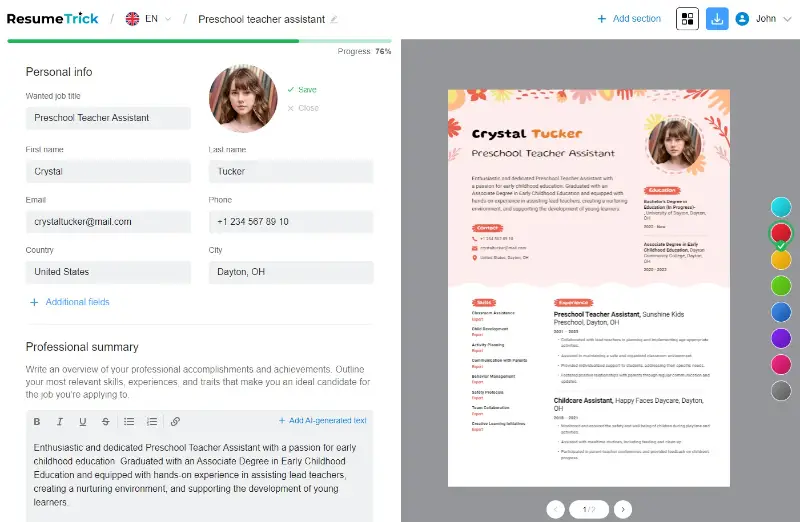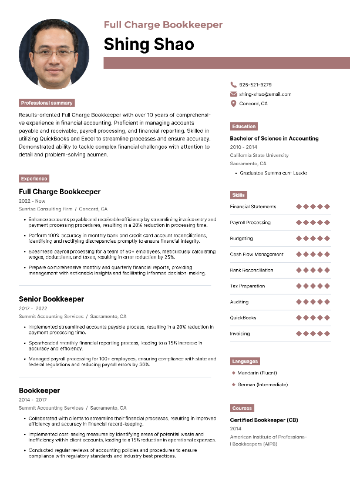Deciding whether to include a picture on a resume is a common dilemma faced by job seekers. While a photo can personalize your application and create a memorable impression, it also carries potential drawbacks and may not be appropriate in all industries.
In this article, we'll examine the pros and cons of resumes with pictures, and ultimately help you decide what is best for you given the specific situation. After all, your resume is the first impression with potential employers, so it's important to consider all aspects.
Should I put my picture on my resume?
Including a photo on a resume can be a contentious topic, with valid arguments on both sides. Understanding advantages and disadvantages of pictures on resumes can help job applicants make an informed decision that best aligns with their career goals and target industry.
Pros:
- Personal connection. A photo can create a more personal connection between the applicant and the hiring manager. It humanizes the resume and may make the candidate more memorable.
- Professional image. For certain industries, especially those where personal appearance is considered important (e.g., acting, modeling, hospitality, sales), a photo can provide an immediate impression of the candidate's suitability.
- Cultural expectations. In some countries, such as Germany and France, it is customary and expected to include a photo. Not having one may make you look unprofessional or less serious about the job.
- Branding. A photo can enhance personal branding, especially if the you have a professional headshot that reflects your professional demeanor and style.
- Immediate recognition. If the resume is one of many documents submitted during a multi-stage hiring process (such as conferences or career fairs), a photo can help the recruiter recall the candidate from previous interactions.
- Visual consistency. Attaching a footage that matches your LinkedIn profile can create a unified, trustworthy online and offline presence.
Cons:
- Discrimination. A resume with a picture can introduce conscious or unconscious bias based on race, gender, age, or appearance. This can lead to unfair treatment and impact the objectivity of the hiring process.
- Unprofessional. It is uncommon in some industries to include a photo on a resume. It might seem unprofessional or as an attempt to influence the hiring process unduly. Your skills and credentials should speak for themselves.
- ATS compatibility. Many companies use Applicant Tracking Systems (ATS) to filter resumes. Images can cause formatting issues and might not be read correctly by these systems, potentially leading to the resume being rejected or overlooked.
In summary, the decision to include a picture on a resume should be made with careful consideration of the industry norms, potential biases, and the cultural context.
When to use a resume photo?
There are certain industries and roles where including a picture can give you an edge over other applicants.
Acting and modeling
Photos are essential in these fields because physical appearance is a key part of getting the job. Casting directors need to see if candidates fit specific role requirement or brand images.
Hospitality and tourism
Personal presentation can be important, particularly in front-facing roles. Employers in these industries often seek candidates with a friendly and approachable demeanor, which a photo can help convey.
Customer service
Positions that involve direct interaction with clients or customers may value personal presentation. A welcoming and professional photo can suggest a candidate’s suitability for a customer-facing role.
Creative fields
Creativity is often valued in such spheres as graphic design, photography, art, etc. A resume picture can showcase the candidate’s personality and style, aligning with their creative portfolio.
Real estate
Personal branding is important for real estate agents as they often market themselves. A professional picture for a resume can help potential clients feel a personal connection and trust.
Education and training
Positions like corporate trainers or educational consultants often involve public speaking and personal interaction. A photo can convey approachability and professionalism, which are important traits in these occupations.
Media and broadcasting
In fields like journalism, television, and radio hosting, visual presentation plays a role in public-facing credibility. A headshot can strengthen the identity.
When should you not put a picture on your resume?
While adding a photo on a resume can be advantageous in certain situations, there are many scenarios where it is better to omit it.
1. Cultural norms
In many countries, especially in Canada, the United States, the United Kingdom, and Australia, it is not standard practice to create free resume with photo. In these regions, resumes are expected to focus solely on skills, experience, and qualifications.
2. Company policies
Many companies explicitly state in their application guidelines that they do not require photos. Ignoring these instructions can make it seem like you haven't done your research or are not following instructions.
3. Corporate roles
Roles in finance, banking, and investment sectors focus on analytical skills, experience, and professional qualifications. Including a photo can be seen as unprofessional and irrelevant.
4. Healthcare
Doctors, nurses, pharmacists and other healthcare professionals are evaluated based on their medical qualifications, experience, and patient care skills. Including a photo is generally inappropriate and not required.
5. Public sector
Positions in government agencies and public administration prioritize experience, organizational skills, and knowledge of public policies. A photo is unnecessary as personal appearance is not a relevant criterion.
In many job spheres, it’s generally best to focus on showcasing your experience and achievements through writing a resume without a photo.
What picture should I put on my resume?
If you've decided to create a resume with a photo, choosing the right picture can significantly impact the impression you make on potential employers.
Guidelines to help you choose the resume photo:
- Opt for a clear, well-lit headshot with a neutral background. A plain backdrop ensures that the focus remains on your face and avoids distractions.
- Wear professional attire that is appropriate for the industry you're applying to. For most professions, business attire such as a suit, collared shirt, or blouse works well.
- Maintain good eye contact with the camera to establish a connection with the viewer. A genuine smile can make you appear more personable and engaging.
- Keep your body language relaxed and natural, with your arms comfortably at your sides or resting on your lap.
- Ensure that the photo is of high quality and resolution, with clear details and no blurriness or pixelation.
- Avoid using photos that may inadvertently offend or alienate individuals from different cultural backgrounds.
- Utilize a recent image that accurately represents your current appearance to maintain consistency when meeting employers in person.
If possible, consider getting a headshot taken by a photographer who specializes in corporate portraits.
Example of a resume with professional picture
How to create a resume with a photo?
Adding a resume picture can be done in a few simple steps.
Format the image
Use a high-resolution photo to avoid pixelation. Typically, a photo size of 600x600 pixels works well. Make sure it doesn't block your resume content.
Insert the photo into your resume
Resume Trick
- Open your web browser and go to the online free AI resume builder.
- If you are creating a new document, select a resume template with photo. If you are editing an existing one, open the resume you want to change.
- In the header area, near your name and contact information, click the "Add you photo" button and select the desired image.
- Once the photo is uploaded, you have options to delete it or adjust the visible area.
- Once satisfied, download the resume in your PDF format.

Create your professional Resume in 10 minutes for FREE
Build My Resume
FAQ
- Should you include a picture on your resume in the LinkedIn profile?
- Yes, LinkedIn profile should include a professional photo as it’s a visual platform and helps create a complete profile.
- What file format should the resume photo be in?
- JPEG or PNG formats are commonly used and widely accepted by most resume builders.
- Should I put a photo on my resume for a job abroad?
- Research the country’s norms. For example, resumes with pictures are common in Europe but less so in the US.
- Should I include a photo in my CV for academic positions?
- Typically, no. Academic CVs focus on publications, research, and teaching experience.
Conclusion
Overall, it's important to weigh the pros and cons carefully and consider whether the presence of a photo adds significant value to your application. In many cases, focusing on the content, format, and relevance of your resume's information may be more impactful.
Ultimately, the decision to put a picture on your resume is just one piece of the puzzle. Focus on showcasing your strengths, crafting a compelling narrative, and presenting yourself in the best possible light.













